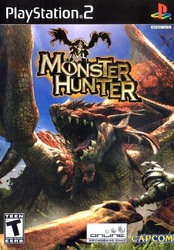Monster Hunter: Difference between revisions
No edit summary |
|||
| Line 18: | Line 18: | ||
==Gameplay== | ==Gameplay== | ||
The gameplay of ''Monster Hunter'' revolves around the player hunting monsters, using their materials to craft new armor and weapons, which then allow for the hunting of new, stronger monsters. This is done via a real-time action combat system, where button inputs from the player immediately translate into movements and actions of the player character. Notably, the players weapons would be controlled via the analog-stick, with different movements corresponding to specific attacks. | |||
{{-}} | |||
The player could choose various weapons to wield, each of which would have a different moveset. <br/> | |||
In the internationally released version, there were 7 weapon classes available: | |||
* Great Sword | |||
* Sword & Shield | |||
* Dual Swords | |||
* Lance | |||
* Hammer | |||
* Light Bowgun | |||
* Heavy Bowgun | |||
{{-}} | |||
==Monsters== | ==Monsters== | ||
Revision as of 22:38, 3 June 2024
| Monster Hunter | |
|---|---|
 | |
| Publisher | Capcom |
| Director | Kaname Fujioka |
| Release | JP: March 11, 2004 NA: September 21, 2004 PAL: May 27, 2005 |
| Platforms | |
| Playstation 2 | |
| Flagship Monster | |
| None | |
| [[{{{Gen}}}]] | |
Monster Hunter is an online hunting action game for the PlayStation 2 console which released on March 11th 2004 in Japan, and the first game in the Monster Hunter series. It was released on September 21st 2004 in North America alongside a multitude of gameplay changes and overhauls.
Premise & Story
The player takes on the role of a "Monster Hunter", a customizable silent mercenary looking for work in the remote town of Kokoto. Under the guide of the village chief, the player advances through the ranks by slaying powerful monsters and earning money for the village. The singleplayer story concludes with a climactic showdown against a Monoblos.
Gameplay
The gameplay of Monster Hunter revolves around the player hunting monsters, using their materials to craft new armor and weapons, which then allow for the hunting of new, stronger monsters. This is done via a real-time action combat system, where button inputs from the player immediately translate into movements and actions of the player character. Notably, the players weapons would be controlled via the analog-stick, with different movements corresponding to specific attacks.
The player could choose various weapons to wield, each of which would have a different moveset.
In the internationally released version, there were 7 weapon classes available:
- Great Sword
- Sword & Shield
- Dual Swords
- Lance
- Hammer
- Light Bowgun
- Heavy Bowgun
Monsters
Monster Hunter featured 13 small Monsters and 17 large Monsters, for a total of 30 Monsters.
Kirin and Fatalis could only be encountered in Multiplayer, while Monoblos was exclusive to the games' singleplayer portion.
Small Monsters
Large Monsters
Locales
Monster Hunter featured 7 maps the player could explore and hunt in.
Additionally, it included two peaceful zones: Kokoto for singleplayer and Minegarde for multiplayer.
Development
Description of the games development. Source whenever possible.
Here is how you use sources[1].
Here is how to use[2] the same source multiple times[2].
Regional Differences
Description of any regional differences. Think MH1JP vs MH1US.
Reception
Monster Hunter became known for its naturalistic environments, immersive gameplay, and strategic action gameplay. Despite being a commercial failure in Japan, North America, and Europe, it was a critical success in its home country, winning Grand Prize at the 8th annual CESA Game Awards. Western critics were mixed on the game, with some considering it a solid (albeit niche) experience, and others calling it clunky and criticizing the control scheme.
Trivia
Various fun facts about the game.
- Arranged in a bullet list like this.
Sources